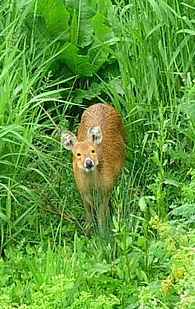Article
Chinese Water Deer
Latin Name: Hydropotes inermis
The Chinese water deer is native to China. They
have tusks instead of antlers and this indicates that it is a very primitive
form of deer. In China they are indigenous to the lower reaches of the Yangtze
River. They were first introduced into the UK in 1873 and kept at London Zoo. In
1896 they were transferred to Woburn Abbey, Bedfordshire and in 1929 32 deer
from Woburn were transferred to Whipsnade Zoo. Most of those now in the wild in
the UK are thought to be descendents of some that escaped. These introductions
into deer parks, and subsequent escapes and releases, have facilitated their
spread, although the wet habitats in the fens of Cambridgeshire and the Norfolk
Broads seem to provide them with the best habitat in which to thrive.
Identification
A small species
intermediate between muntjac and roe deer. Their ears large and rounded
and their coat a russet-brown in summer pale to grey-brown in the winter. They
do not have antlers but large protruding tusks in bucks (males), which are
generally only visible in adults. The tusks are used as weapons during the rut
and in defence against predators.
|


Hugh
Venables
 |
|
Animal
Facts
In Britain: All year
Life Span: Up to 6 years, although up to
40% of fawns die within the first four weeks of life.
Statistics: 11-18kg, 50-55cm at shoulder. Little variation between sexes.
Habitat: Reed beds, river shores, woodlands
and fields. A good diversity of plants in the under-storey (herbaceous and shrub
vegetation below the canopy) is important.
Food: Selective feeders that take small
morsels from nutritious plants, especially herbs but may take woody browse,
grasses and sedges if food is limiting.
Breeding: Does give birth during May to
July after a 6-7 month gestation. Up to 6 fawns may be born, but 1 to 3 is more
usual. The does give birth to spotted young in the open and then quickly takes
them to concealing vegetation will they will remain for up to a month.
|
Conservation
Status

Near Threatened |
Distribution: Currently restricted to Bedfordshire, Cambridgeshire,
Norfolk and Suffolk with a few scattered sightings elsewhere.
Behaviour: Solitary except when mating. Bucks are highly territorial and
particularly aggressive and do not tolerate the presence of other bucks.
Confrontations between males begin with the animals walking slowly and stiffly
towards each other, before turning to walk in parallel assessing one another. At
this point, one male may succeed in chasing off his rival, making clicking
noises (whickering) during the pursuit. However, if the conflict is not resolved
at the early stage, the bucks will fight. Each trying to wound the other on the
head, shoulders, or back, by stabbing or tearing with their upper canines
(tusks). The fight is ended by the loser, who either lays his head and neck flat
on the ground, or turns tail and is chased out of the territory. Numerous long
scars and torn ears seen on males indicate that fighting is frequent. The fights
are seldom fatal but may leave the loser considerably debilitated. Both sexes
give a short bark when alarmed or as a warning and scream when chased. Whistling
and squeaking is emitted by the buck as he follows a doe during courtship. The
doe also emits a soft pheep to call to their fawns. They are active day and
night, but peak time for activity is around dusk.
The rut is between November and December and
during this time the bucks and does form pairs and defend territories and stay
together until April. You may also find tufts of fur on the ground amongst the
vegetation around this time of year.
Conservation Status: IUCN Red Data Book listed as "lower risk, near
threatened" in China. The British population is thought to account for 10% of
the world's population.
See Also
Deer
Topic Index

Where to Photograph Deer
in the UK

Photographing deer

Wikipedia
- Water Deer

British Deer Society

Deer Commission
for Scotland

|